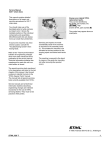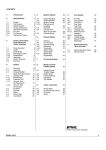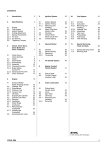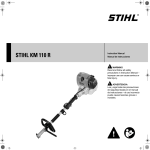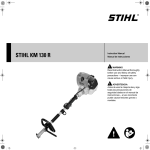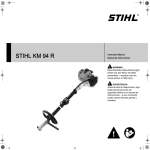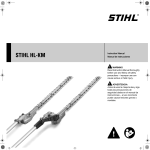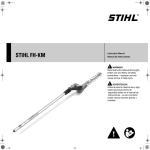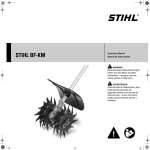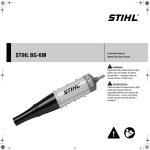Download Technical Information
Transcript
Technical Information 24.2008 New STIHL KM 56 KombiMotor – Series 4144 Contents 1. 2. 3. 4. 5. 6. 7. Technical description Specifications KombiTools Special accessories Servicing accessories Spare parts Servicing TI_24_2008_30_01_02.fm englisch / English USA Page 2 Technical Information 24.2008 The new KombiMotor stands out by virtue of its modern appearance and exceptional ease of use. 1. Technical description The overall concept was designed for high reliability, ruggedness and low maintenance requirements. 1.1 Function of stop switch and ignition The ergonomically designed operating elements, together with the favorable power-to-weight ratio and easy starting, make these machines easy to handle and comfortable to use. 1 The following KombiTools are currently available: FS-KM, FSB-KM, HL-KM 0°, HL-KM 135°, FH-KM 135°, BG-KM, HT-KM, BF-KM, FCB-KM, FCS-KM, KB-KM and KW-KM, as well as the HT Shaft Extension and HT/HL CFK Shaft Extension. The KombiTools can be ordered individually. By swapping the KombiTools, it is possible to cover a broad range of applications and uses. The multi-purpose STIHL KombiSystem is highly versatile: Customers can choose which KombiTool they want supplied as original equipment with their KombiMotor. 546TI000 KN The KombiMotor (abbreviation "KM") is available with a loop handle and Easy2Start!™ as the KM 56 RC. When the loop handle is used with a barrier bar, all KombiTools can be connected to the KombiMotor without restrictions. When the stop switch (1) is not actuated, it remains in the position Run: The ignition is on – the engine is ready for starting and can be started. If the stop switch is pressed into the position 0, the ignition is switched off. Once the engine comes to a complete stop, the ignition automatically resets so the engine can be started. 1.2 Choke lever KombiMotor and KombiTool can be easily transported and stored in minimum space. 546TI001 KN 1 To start the engine, the choke lever (1) must be pressed and rotated to the position Cold start g or Warm start <. Once the engine has been started and the interlock lever and throttle trigger have been engaged, the choke lever automatically returns to the position Run F. It will not be necessary to move the choke lever to the position Run F by hand. TI_24_2008_30_01_02.fm Technical Information 24.2008 1.3 Page 3 Loop handle 1.5 Engine with stratified scavenging 1.5.1 Mechanical Design 547TI001 KN A The new machine is delivered with the loop handle pre-assembled on the unit. The barrier bar mounts with just one screw, so the KombiMotor can be used with all KombiTools. The barrier bar must be mounted before delivery of the KombiMotor. 1.4 Versions with STIHL Easy2Start™ . for reduced cranking effort and lower cranking speed . smooth starts TI_24_2008_30_01_02.fm 3 2 4 1 546TI002 KN When the loop handle is secured flush against the engine housing, the recommended minimum distance (A) between the loop handle and controls is ensured by the design of the loop handle. The distance is approx. 7.9 in (200 mm). No additional aids are required for setting the minimum distance. Fresh mixture (1) and clean air (2) are fed into different ports via the carburetor. Integrally molded control channels (3) on both sides of the piston skirt. Open and close the connection between the clean air port and the transfer port (4). No additional components are required for controlling the clean air. An air cushion (air without fuel) separates the fresh mixture (fuel-air mixture) and exhaust. The air cushion is placed in front of the fresh mixture. At the beginning of the "exhaust and transfer" stroke, air without fuel flows from the transfer ports into the combustion chamber purging the exhaust gases and preventing the incoming fresh mixture from exiting the exhaust port. This results in reduced emissions through the reduction of fresh mixture losses and lower fuel consumption. Page 4 1.5.2 Technical Information 24.2008 Carburetor 4 6 2 3 2 6 3 5 546TI003 KN 1 a) Full load, partial load b) Idle c) Cold start d) Warm start Full load and partial load Cold start The air filter (1) divides the intake air into two streams. The choke shutter (2) and throttle shutter (3) are open. The intake air flows above and below the choke and throttle shutters through the carburetor (4). The fuel is drawn into the top part of the carburetor and flows through the venturi – where the fresh mixture is formed. The spacer flange (5) channels the fresh mixture into the crankcase and the clean air into the transfer ports. During a cold start, the choke shutter is closed. The throttle shutter is slightly open. The amount of air necessary for an optimal starting mixture is drawn in through the air bleed holes in the choke shutter; the necessary amount of fuel is drawn in from the idle and main jet. In the carburetor, there is a baffle plate (6) that separates the fresh mix and clean air paths from one another. Warm start During a warm start, the choke and throttle shutters are opened to a defined angle so an ideal mixture of air and fuel is fed to the engine for starting. Idle The choke shutter is open. The throttle shutter is closed so that only a small gap remains open at the carburetor housing. A rich mixture is drawn in through the idle hole located at the gap. Air dilutes the rich mixture into an optimal idle mixture which is then drawn into the crankcase. TI_24_2008_30_01_02.fm Technical Information 24.2008 2. Specifications 2.1 Engine Page 5 Single cylinder two-stroke engine Displacement: 1.66 cu. in (27.2 cc) Bore: 1.34 in (34 mm) Stroke: 1.18 in (30 mm) Engine power to ISO 8893: 1.08 bhp (0.8 kW) Torque: 0.99 lbs.ft (1.35 Nm) Idle speed: 2800 rpm (1/min) Clutch engages at: 4200 rpm (1/min) Cut-off speed (Nominal value): 10000 rpm (1/min) Starter mechanism: – Starter rope: – Pull-out reserve: 2.2 Dual pawl system Diameter 0.106 in, length 35.8 in (Diameter 2.7 mm, length 910 mm) 1.25 – 2.25 revolutions Fuel system Carburetor: all-position diaphragm carburetor with integral fuel pump. Settings High speed screw H (basic setting) – without limiter cap for servicing dealers: – with limiter cap for users: 1 1/2 turns open 3/4 turn counterclockwise (max. to stop) Low speed screw L (Standard setting): 3/4 turn counterclockwise Idle speed screw LA: As required, cutting tool must not turn Fuel tank capacity: Fuel mixture: Mix ratio: 2.3 11.5 fl.oz (340 cc) See instruction manual See instruction manual Ignition system Ignition module: Spark plug (suppressed): Electrode gap: TI_24_2008_30_01_02.fm with electronic magneto ignition NGK CMR 6 H 0.020 in (0.5 mm) Page 6 2.4 Technical Information 24.2008 Weight and dimensions KombiMotor, with Easy2Start™ Overall length without KombiTool Weight without KombiTool, without fuel KM 56 RC: 33.1 in (840 mm) 9.5 in (4.3 kg) KombiTools Overall length without KombiMotor Weight without KombiMotor FS-KM: 37.0 in (940 mm) 2.6 lbs (1.2 kg) 1) FSB-KM: 30.3 in (770 mm) 1.6 lbs (0.7 kg) 1) HL-KM 135°: 63.0 in (1600 mm) 5.7 lbs (2.6 kg) HL-KM 0°: 45.7 in (1160 mm) 4.0 lbs (1.8 kg) FH-KM 135°: 52.4 in (1330 mm) 5.3 lbs (2.4 kg) BG-KM: 35.0 in (890 mm) 4.0 lbs (1.8 kg) HT-KM: 49.6 in (1260 mm) 4.2 lbs (1.8 kg) 2) BF-KM: 39.4 in (1000 mm) 9.0 lbs (4.1 kg) 3) FCB-KM: 36.2 in (920 mm) 4.9 lbs (2.2 kg) 4) FCS-KM: 39.4 in (1000 mm) 5.7 lbs (2.6 kg) 4) KB-KM: 49.2 in (1250 mm) 14.1 lbs (6.4 kg) 3) KW-KM: 49.2 in (1250 mm) 16.3 lbs (7.4 kg) 3) R = Loop handle 1) 2) 3) 4) Without cutting attachment, without deflector Without bar and chain With deflector With cutting attachment and deflector TI_24_2008_30_01_02.fm Technical Information 24.2008 KombiTools 3.1 KombiTools The following KombiTools are available: KombiTools Intended use FS-KM Trimmer with mowing head FS-KM Trimmer with grass cutting blade FSB-KM Trimmer with curved shaft and mowing head HL-KM 135° Hedge trimmer, adjustable HL-KM 0° Hedge trimmer FH-KM 135° Power Scythe, adjustable BG-KM Blower HT-KM Pole pruner BF-KM Soil cultivator FCB-KM Edger FCS-KM Edger KB-KM Bristle brush KW-KM STIHL PowerSweep™ 1 Extension drive tube, approved for use on HT-KM only 2 Carbon Extension drive tube, approved for use on HT-KM, HL-KM 0° and HL-KM 135° Information regarding loop handle with barrier bar – see b 1.3 TI_24_2008_30_01_02.fm FH-KM 1 FS-KM HT-KM 2 BG-KM FSB-KM FS-KM BF-KM KB-KM FCB-KM FCS-KM KW-KM 470TI004 KN 3. Page 7 Page 8 3.2 Technical Information 24.2008 Cutting attachments for FS-KM The following cutting attachments are approved for FS-KM: 1 2 3 4, 5 6 7, 8 Mowing heads 1 STIHL SuperCut™ 20-2 4002 710 2184 2 STIHL AUTOCUT® C 25-2 4002 710 2196 3 STIHL AUTOCUT® 25-2 4002 710 2191 4 STIHL TrimCut™ 30-2 4002 710 2193 5 STIHL TrimCut™ 31-2 4002 710 2156 6 STIHL PolyCut™ 20-3 4002 710 2189 7 STIHL FixCut™ 25-2 4001 710 2131 8 STIHL FixCut™ 25-2 4002 710 2158 Metal cutting tools 9 10 681TI168 KN 9 3.3 Grass cutting blade 230-4 4001 713 3801 10 Grass cutting blade 230-8 4001 713 3803 All cutting attachments listed must be used with approved deflectors (see catalog "Cutting Attachments & Accessories for Brushcutters and Trimmers"). Cutting attachments for FSB-KM The following cutting attachments are approved for FSB-KM: Mowing heads 1 STIHL AUTOCUT® 11-2 4004 710 2192 2 STIHL PolyCut™ 5-3 4004 710 2180 1 2 002TI034 BL All cutting attachments listed must be used with approved deflectors (see catalog "Cutting Attachments & Accessories for Brushcutters and Trimmers"). TI_24_2008_30_01_02.fm Technical Information 24.2008 4. Special accessories 4.1 General Page 9 Part name Part No. Harness 4130 710 9000 Full harness 4119 710 9001 Spool with nylon line for mowing heads STIHL SuperCut™ 20-2, AUTOCUT® C 25-2, AUTOCUT® 25-2 Replacement blades (pack of 12) see catalog "Cutting Attachments & Accessories for Brushcutters and Trimmers" 4111 007 1001 Transport guard 4119 790 3906 for grass cutting blades 4.2 Use for mowing head STIHL PolyCut™ 20-3 Nylon line for mowing heads Line diameter / color Use 0.095 in (2.4 mm) / orange STIHL SuperCut™ 20-2, AUTOCUT® C 25-2, AUTOCUT® 25-2, TrimCut™ 30-2, TrimCut™ 31-2, STIHL PolyCut™ 20-3, FixCut™ 25-2 AUTOCUT® 25-2, TrimCut™ 30-2, TrimCut™ 31-2, STIHL PolyCut™ 20-3, FixCut™ 25-2 0.105 in (2.7 mm) / red TI_24_2008_30_01_02.fm Page 10 Technical Information 24.2008 5. Servicing accessories 5.1 Special tools The following new special tools are required for the KM 56 RC: 8 a 5910 893 1708 A 1 2 The sleeve (1) of installing tool 5910 890 2208 has a new camfer angle (a) of 20 degrees. The previous sleeve had a camfer angle of 45 degrees. The new sleeve 5910 893 1708 replaces previous sleeve 5910 893 1703. Recommendation: Retrofit special tool 5910 890 2208 with new sleeve 5910 893 1708 and update existing stocks of special tool 5910 890 2208 with the new sleeve 5910 893 1708. 901TI065 KN 3 Flange (2) 5910 850 4200 replaces previous flange 1128 850 4200. The new flange has an additional recess at the sealing surface facing the spacer flange. The puller (3) has a 3/8" thread and may only be used for Series 4144 and 4140. This puller cannot be used with metric threads because thread damage will occur. The existing special tools are listed in the service manual for STIHL KM 56 RC. Item Part name Part No. Use 1 Sleeve 5910 893 1708 2 3 Flange Puller 5910 850 4200 5910 893 0800 Installing hookless snap rings in pistons (supplement to installing tool 5910 890 2208) Engine leakage test Removing the flywheel TI_24_2008_30_01_02.fm Technical Information 24.2008 5.2 Page 11 Aids Part name Part No. Use Starter rope 35.8 in (910 mm) 4137 195 8200 Rewind starter ElastoStart™ (special accessory) – Starter rope 35.8 in (910 mm) 0000 190 3403 4137 195 8200 Starter mechanism (handle with rope) Set of carburetor parts 4241 007 1002 Carburetor Zama C1M-S145 Carburetor Zama C1M-S146 (only for California) STIHL gear lubricant for hedge trimmers – 3 oz (80 g) tube – 8 oz (225 g) tube Drive shaft in drive tube 0781 120 1109 0781 120 1110 NEW: STIHL fitting paste – 1.8 oz (50 g) tube 0781 130 1014 STIHL special oil – 3.4 fl.oz (100 ml) bottle 0781 417 1315 Standard solvent-based degreaser not containing any chlorinated or halogenated hydrocarbons 6. Paste contains molybdenum sulfide and graphite; use for lubrication between crankshaft stub and clutch drum Rewind spring in rewind starter Bearing bore in rope rotor Cleaning the crankshaft stub and cone on the flywheel (see TI 25.2005) Spare parts Separate spare parts documentation will be available for KM 56 RC when it is launched on the market. 7. Servicing The safety instructions in the instruction manual must be observed if the machine is started during servicing. 7.1 Service manuals The following manuals can be used for repairs within the KombiSystem: For KombiMotor KM 56 RC (powerhead 4144) Service manual Powerhead 4144 0455 938 0123 TI_24_2008_30_01_02.fm Service manual Components 4144 0455 545 0123 For the KombiTools Service manual KombiTools 0455 227 0123 Page 12 7.2 Technical Information 24.2008 Tightening torques . The tightening torques are specified in the service manual. When using press fluid OH 723, apply press fluid to the ends of the hose and connectors prior to installation. Notes regarding press fluid OH 723 7.3 First use after long periods of storage In isolated cases, problems may be experienced with starting when the machine is stored over a period of several months and at temperatures under (40 degrees) 5 °C. In this case, press the manual fuel pump several times in order to purge the carburetor. Afterwards, wait a few minutes, then start the engine. Press fluid OH 723 produces a lubricant film to aid in assembly. The lubricant evaporates after a short time allowing for a tight fit. Never use fuel, oil or grease as a lubricant. Fuel, oil and grease does not evaporate and may allow the hose to slip from the connector. Recommendation: Before storing the machine for an extended period, always run the engine until the carburetor is dry, otherwise the carburetor diaphragms may stick together – see also "Storing the machine" in the owner's manual. Maintenance and Repairs 7.4.1 Barbed connectors on the carburetor 546TI009 KN 7.4 The carburetor has two barbed connectors (arrows) on which the fuel hoses are seated. In order to ensure there are no leaks in the fuel system, it is important to follow the steps listed below: . Install and remove fuel hoses, by hand whenever possible, in order to avoid damage to the barbed connector – sharp-edged pliers, screwdrivers, etc., must not be used – nor should fuel hoses be cut open with a knife or similar implement. . Do not reuse fuel hoses after disassembly, always replace them with new hoses – fuel hoses may be over-extended when removed. . Install new fuel hoses dry or with the aid of press fluid OH 723 – 0781 957 9000. Other press fluids are not permitted and may lead to fuel hose damage. TI_24_2008_30_01_02.fm Technical Information 24.2008 7.4.2 Page 13 Installing the clutch drum 7.5 Serial number For installation of the clutch drum (1), the crankshaft stub (arrow) must be lubricated with the new fitting paste 0781 130 1014. 2 546TI011 KN a Coat the crankshaft stub (2) with fitting paste in area a = 0.4 in (10 mm). Notes regarding fitting paste: If fitting paste is not applied to the crankshaft stub or the carburetor is improperly adjusted, the cutting tool may rotate when the machine is idling. If the cutting tool turns when the machine is idling, check for proper carburetor adjustment and verify fitting paste has been applied to the crankshaft stub. The fitting paste can also be used with the previous models FS 45, FS 55 and KM 55. TI_24_2008_30_01_02.fm 546TI005 KN 546TI010 KN 1 The serial number is located in two places on the underside of the engine housing – as shown in the illustration. Page 14 7.6 Technical Information 24.2008 Repair times The specified repair times apply for trained and qualified personnel as well as for properly equipped repair shops. The repair times are specified in minutes. This table for the KM 56 RC can be added to the STIHL repair times table. Code Type of Repair 2 3 4 5 6 7 8 Replace crankcase, crankcase gasket or re-seal crankcase. Includes air leak test. Replace crankshaft main bearing(s). Includes air leak test. Replace crankshaft seal(s). Includes air leak test. Perform engine air leak test. Replace cylinder and/or piston. Includes air leak test and repair of components causing failure. Replace ignition module or flywheel. Includes stop circuit test. Replace fuel tank line, tank vent, or fuel pick-up body. © ANDREAS STIHL AG & Co. KG, 2008 KM 56 RC 50 50 50 30 50 Code Type of Repair 9 10 11 12 13 14 15 16 17 18 19 21 22 40 45 30 50 KM 56 RC Replace intake manifold or intake flange. Repair or replace carburetor. Includes fuel system testing. Repair throttle control. Repair or replace rewind starter. Repair or replace clutch, clutch shoes or clutch springs. Replace muffler. Replace air filter or filter housing. Repair or replace stop switch. Includes circuit testing. Replace clutch housing. Replace outer drive tube. Replace shaft coupler or gear box. Replace drive shaft. Replace fuel tank. Miscellaneous repairs and other repairs not listed. Handling allowance only-no labor. No labor. 20 30 20 15 30 15 15 25 20 30 15 15 20 15 10 0 20 Technical Documentation D1/MTK-ke TI_24_2008_30_01_02.fm














